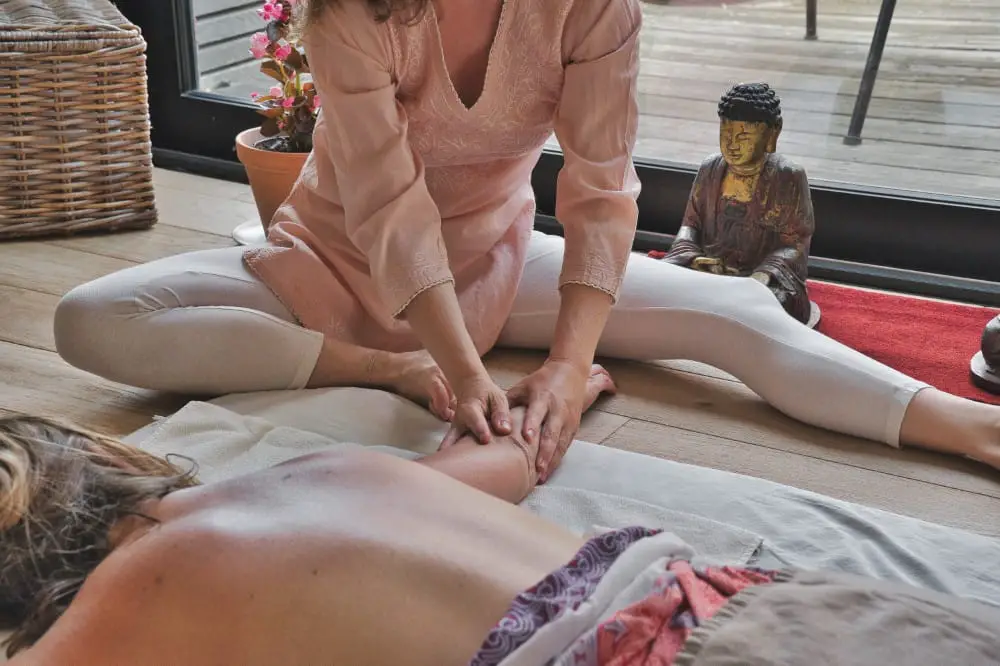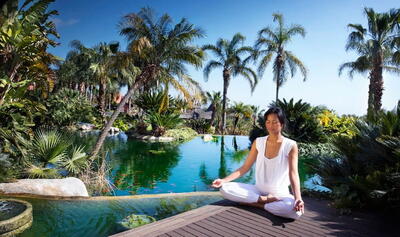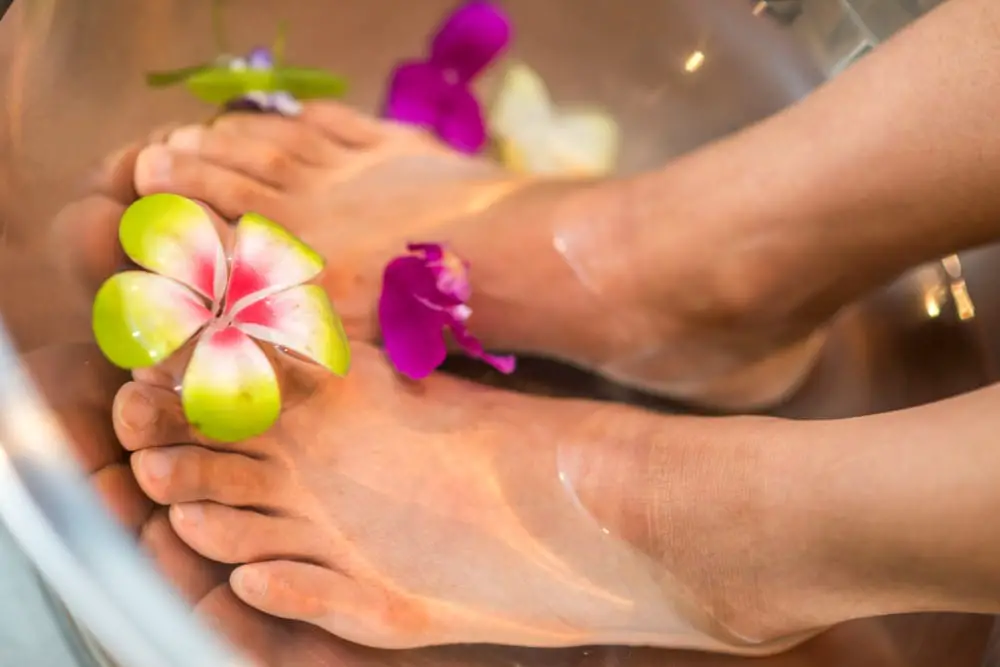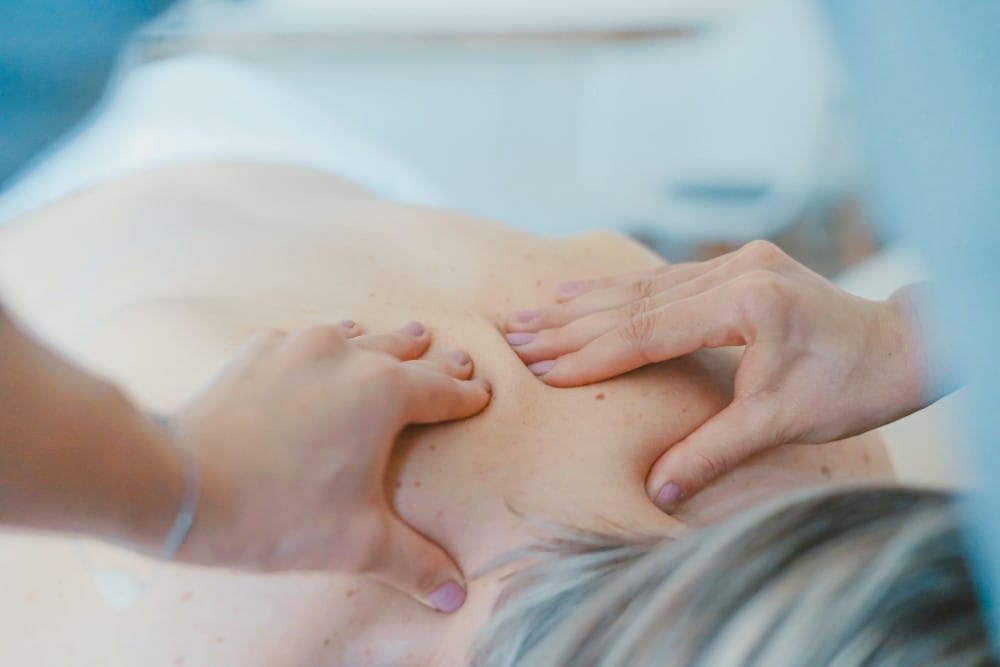
For some years now, Thai massage has become one of the most demanded types of massage.
This type of massage, which, along with other ancient techniques of oriental origin, has arrived in our country relatively recently, has become one of the treatments that we most like to receive.
However, despite having become a trend among the top beauty, relaxation, and wellness treatments, Thai massage remains a great unknown.
Do you want to know what is Thai massage, its origins and all its benefits?
Keep reading, because we have prepared for you a guide in which we will tell you all the secrets of this relaxing oriental massage.

Are you looking for an establishment where you can try Thai massage?
CONSULT OUR SEARCH ENGINE TO FIND ESTABLISHMENTS OFFERING THAI MASSAGE!
What is Thai massage and what does it consist of
Traditional Thai massage is a body therapy whose aim is to make you reach a state of deep relaxation and promote balance between body, mind, and soul.
It focuses on the energy lines, or what is the same, a sort of "road network" that runs through our body, forms our energy system, and brings us what traditional Thai medicine calls "Lom" or "Prana", the vital force.
Traditional Thai medicine, one of whose branches is Thai massage, considers that there are more than 70,000 of these roads or energy lines, although it works with the 10 main ones, which flow into the body and therefore directly influence the organism.
This type of massage is both a relaxing and relaxing treatment and can have both therapeutic and preventive purposes.
That is, you don't need to wait until you feel bad to enjoy all its benefits. Taking a good Thai massage on a frequent basis, just for prevention, can be a fantastic idea for your health.
The aim of Thai massage is to get you to relax and remove the blockages that are reflected in your body because of tension, nerves, and stress ...
The physical and mental work of this technique achieves an optimal distribution of body energy, by unblocking the energy lines Sen, through the application of pressure in a rhythmic and intense way.
Pressure is also applied on some specific points of the body, so as to release tension in the muscle tissue in a deeper way than with other types of massage.
It should be noted that Thai massage, although it is a massage that achieves body relaxation, is not a relaxing massage as we understand it in the West. At various times during the treatment, pressure is applied with great force, so you may feel discomfort.
Thai massage begins with the manipulation of the soles of the feet and then spreads over the rest of the body, combining various techniques taken from shiatsu, Indian ayurveda, meditation, yoga, and traditional Chinese medicine.
Throughout the session stretching phases and massage phases alternate, without the presence of oils or creams (although there are types of Thai massage in which such products are used), pressing with fingers, hands, arms or feet and mobilizing the body while stretching from different angles and controlling breathing.
The practice of Thai massage relates to the practice of compassion, kindness, and love preached by Buddhism, so it is not just about stretching or pressing, but a whole experience in which holistic care, attention, and well-being are placed at the center.
All this makes it a kind of sacred "dance", of harmonious and fluid movements, which constitutes a whole art.
Where does Thai massage come from?
Where does Thai massage come from? Where does it come from?
It is one of the four branches of traditional Thai medicine, which gives it special protection by the Thai government, in addition, it was declared Intangible Cultural Heritage by UNESCO in 2019
So old, that this technique is believed to be more than 2,500 years old.
Legend has it that it was invented by the Buddha's physician and friend, Shivago or Zhivago Komparai, who is also believed to have been in the service of the king of Magadha, Bimbisara, along with the Buddhist monks of the Sangha.
In reality, the origin of Thai massage is uncertain. For centuries the Buddhist monasteries were in charge of transmitting the knowledge about this technique orally, forming part of a secret code, which was only passed from master to disciple so that it would not fall into oblivion.
A large part of the records on Thai massage was lost in 1767, during a Burmese attack on Ayutthaya, so we do not know its exact origin.
What we do know is that it is linked to the development of traditional Thai medicine and draws from various techniques from India, China, and other regions of Southeast Asia.

Are you looking for an establishment where you can try Thai massage?
CONSULT OUR SEARCH ENGINE TO FIND ESTABLISHMENTS OFFERING THAI MASSAGE!
What are the benefits of having a Thai massage?
The technique of Thai massage, by dealing with the whole body and being focused on seeking relaxation both physically, mentally and energetically, activates almost all systems of the body and is therefore very beneficial, especially if you incorporate it into your regular routine.
-
It is a revitalizing massage, so you will feel more energetic after receiving it and you will reduce physical fatigue.
-
It works the whole body, from the soles of the feet to the scalp, so the relaxation is not only in a particular area, but is felt comprehensively. You will feel your body and mind completely renewed after the treatment.
-
This makes you feel lighter and more flexible, after applying pressure and stretching on all your extremities and other strategic points of your body.
- They will feel lighter and more flexible after the treatment.
-
It relieves tension and blockages caused by stress and promotes deep and restful sleep, making it very effective against insomnia.
-
By attending to both the body and the mind, it increases the feeling of peace and tranquility and helps to manage emotions that cause us discomfort and discomfort with more calm and serenity.
- It is very effective against insomnia.
-
It stimulates the immune system, so you get to prevent diseases and feel healthier in your day to day.
-
Improves blood and lymphatic circulation.
-
It is very effective against back pain, and headaches, and relieves symptoms of diseases such as arthrosis, arthritis or scoliosis.
-
Stretching helps you recover mobility and flexibility progressively, as well as improving muscle tone.
-
It increases body awareness and movement control, so you feel more confident and agile.
-
It is very effective against muscle contractures that form due to poor posture or stress.
The list of benefits is huge and here are the most important ones, but surely if you ask the fans of this type of massage, they will tell you many more.
Who can get a Thai massage
Almost anyone can enjoy the benefits of a good Thai massage.
No matter your age, weight, or size, anyone can receive a Thai massage, adapt to their life circumstances, and enjoy all its benefits.
However, like any treatment, it has contraindications that require certain precautions to be taken when performing the technique, or even advice against its application.
This is the case of people suffering from infectious conditions (both for the possible risk of contagion that may exist, as well as for the stimulation of circulation, which could interfere with the patient's recovery process).
It is also not recommended during episodes of fever or in cases of fibrosis and degenerative muscle diseases.
In general, the contraindications of Thai massage are the same as for other types of massage:
-
If you are hypertensive or, on the contrary, if you have episodes of low blood pressure.
-
If you have cardiac problems.
-
If you are under the influence of alcohol or any drug at the time of receiving the massage, it is better to wait to do it.
-
If you have had a stroke.
-
In case of edema, significant varicose veins or phlebitis.
If you suffer from a herniated disc.
-
If you have suffered hamstring tears.
-
You should also wait if you have open wounds, recent bleeding or burns and if you suffer from erythema or have fungus.
-
If you have cancer lymphatic or otherwise.
- If you have cancer or lymphatic.
-
In the case of luxations.
And during pregnancy, can I have a Thai massage?
In the case of pregnancy, and as with all types of massages, you will find all kinds of opinions about it.
There are those who totally discourage it and those who are strong advocates of its benefits (remember that a good masseuse will adapt the massage to the circumstances and needs of the person receiving it).
For Thais, it is an excellent idea to accompany the stage of pregnancy with this technique since, as you know, promotes relaxation, and flexibility, is very effective against contractures, releases muscle, and mental tension, and helps to restore energy, very important at a stage in the life of women in which the process of giving life consumes us almost completely.
A good masseuse will take into account at all times your vital state, as well as your state of health and will choose the most suitable areas to apply the massage, in addition, to modulating the tension and pressure points, so that it does not hurt you, nor your baby.
You will also learn which areas of the body, such as the inner thighs, should not be manipulated during the massage to avoid the risk of premature birth.
Since Thai massage is applied on a tatami mat, or on a large table that the masseuse can climb onto, it is easier for him/her to help you get into a comfortable position, either on your side or on your back.
However, it is advisable to wait until the first trimester is over to apply the massage and consult beforehand with health professionals who accompany you during pregnancy in case there is any medical contraindication in your particular case.


Are you looking for an establishment where you can try Thai massage?
CONSULT OUR SEARCH ENGINE TO FIND ESTABLISHMENTS OFFERING THAI MASSAGE!
What types of Thai massage are there?
Thai massage is a massage technique that has been passed down virtually by word of mouth for centuries.
Thus, there is no one way to perform it. In fact, in Thailand, you will find major differences between Thai massage in the northern parts of the country and those in the south.
They share, however, some common features, such as the use of stretching and pressure when performing the massage, the application on the floor or on tatami and that the person receiving it is dressed in comfortable, light, and loose clothing, in addition to cotton underwear.
But in addition to these variants, there are many others that make this massage decontracting a very attractive treatment. Shall we review some?
Foot massage
This technique, with which traditional Thai massage usually begins, is a treatment originating in China that was born from the union of foot reflexology, shiatsu, and yoga.
In Thai culture, the feet represent the state of health of the body, which is symbolized along the entire sole.
It can be said that the feet are, in a way, like a "map" of the human body. Therefore, by massaging a particular point of the foot, the effect is reflected in the corresponding area of the body.
Oil massage
Although using oils is not part of the ritual that constitutes traditional Thai massage and we cannot speak of pure Thai massage when such substances are used, sometimes you can also find centers where Thai massage is applied by adding essential or vegetable oils.
This way the benefits of aromatherapy are taken advantage of and combined with techniques that belong to Thai massage and that contribute to relaxation.
Thai massage with herbal pindas
Pindas are linen sachets that are filled with aromatic and medicinal plants and heated by steaming in order to use them during the massage to enrich the massage and take advantage of all the benefits of the heat and the plants.
They were formerly compresses used during wars to apply to open wounds, infusing them first with hot water. Over the years their use changed and now they are used to choosing some plants or others, depending on the effect we want to achieve.
In Thai massage with herbal pindas manual contact is replaced by therapeutic pindas to achieve an effect that can be relaxing, anti-inflammatory, analgesic, and decongestant ... thanks to the combination of heat, humidity, the aromatherapy, and the properties of the plants.
However, you should avoid this type of massage if you have burns, bruises, open wounds, acute dermatitis, severe joint or soft-tissue inflammation, hypertension, or varicose veins.
Lanna Tok Sen or Thai hammer massage
The Thai expression tok sen means "hit on the lines."
And that is precisely what this type of Thai massage is all about a wooden instrument is slid over the skin tapping along the Sen lines, as well as muscles and tendons.
It is called Thai hammer massage because the instrument used to strike (firmly, but gently, no harm is intended) is actually a set of two tools that function as a hammer (hon) and a chisel (lim).
This type of Thai massage is of unknown origin, although it is believed that it may be about 5000 years old and has been practiced in the ancient Lanna region of northern Thailand for about 1400 years.
It is said to have arisen to relieve the discomfort and tiredness of workers in the rice fields.
This form of Thai massage application is based on the fact that the strokes produce a vibrating wave that acts like a stone when thrown into the water, generating a kind of shock wave that reaches the soft tissues and helps repair them.
In the tok sen there are two very distinct phases:
First, quick, light, superficial strokes are applied, sliding the "chisel" along the sen lines and stimulating the area as a way of preparing it.
And then the massage continues with dry, slow, and deep strokes, which produce an effect comparable to that of ultrasound devices used in physiotherapy and helps to dissolve contractures.
Thai massage and yoga - how are they related?
If you've ever heard of Thai Yoga, you're probably wondering how yoga and Thai massage are related.
As you already know, Thai massage is a technique that draws, among other sources, from yoga. And, in fact, the Yoga-Thai technique is a type of passive yoga developed in Thailand, but which has much in common with the traditions of India.
Thus, the pressure of Thai massage is combined with the postures and stretches of passive yoga.
On the other hand, both yoga and Thai massage work on a physical, corporal, mental, and spiritual level, in addition to the fact that in both disciplines breathing is used to create that connection between body and spirit.
Is a Thai massage the same as a Balinese massage?
Although they are both oriental massages, and they share some techniques and fundamentals, the truth is that Thai massage and Balinese massage are two very different types of massage from each other.
Thai massage is a deep, relaxing, and invigorating type of massage, which acts on the muscles and tissues, while Balinese massage is sensitive, relaxing, and gentle.
The ancestral Balinese massage seeks to achieve a state of integral harmony through three elements: water, air, and fire, which represent the digestive, nervous, and hormonal systems.
It is applied by combining kneading, stretching, and pressure techniques using any part of the body, such as feet, knees, elbows... but in a softer and more sensitive way than in Thai massage.
Where to learn how to give a good Thai massage?
With the rise of Thai massage in the West, there are many therapists who want to train in this technique to help improve the health of the people they work with.
The truth is that there are several ways to achieve this.
In Spain, there are several massage schools that have specialized teachers, trained in schools in Thailand and very well-valued.
The biggest advantage of training in one of these centers is the possibility of international certification.
Some schools with good references are Art Thai Massage, ISED Asturias, the Escuela Española de Masaje Tradicional Tailandés or the escuela Rak Saeng.
You can also go to the original source of the knowledge and get trained in Thailand.
There are two main schools of Thai massage, the Watpho Thai Traditional Medicine School, which is located in a monastery in Bangkok and the one in Chiang Mai.
Establishments to renew yourself with a luxury Thai massage
But if what you want is to put yourself in the best hands to receive a good Thai massage you also have very interesting options, such as some of the Thai massage schools that we have left you in the article or centers like The Organic Spa Madrid, one of the few centers you will find in Spain to receive a Thai massage from expert therapists qualified in both this type of massage and Balinese massage and other types of therapies of Asian origin.
In conclusion, Thai massage is one of the most complete massage treatments you can receive to take care of your body, mind, and spirit. And it is not surprising that it has become fashionable in the West, checking all the benefits it can offer you.
And you, have you tried it yet?

Are you looking for an establishment where you can try Thai massage?
CONSULT OUR SEARCH ENGINE TO FIND ESTABLISHMENTS OFFERING THAI MASSAGE!





